“It was not death for I stood up,/And all the dead lie down” Emily Dickinson
The ultimate adventure is one that cannot be described; it must be experienced. “The Future of Death,” a performance installation created by the A2 Company was presented at the Bezalel, Yaffo 23, Jerusalem gallery last Thursday, June 23, 2011 as the culmination of a two week workshop by Alit Kreiz and Anton Mirto of A2, along with the workshop participants.
The description of the event on the A2 website is almost deceptively simple: Forty people gradually bury each other with earth in front of a live audience.
Entering the gallery space with a mixture of anticipation and reluctance, I wondered what that meant. The rectangular room, designed for the Life/Art project by Hillel Roman, was arranged with seating around all four sides, and in the center a large coffin-shaped space. I was curious, and had seen a previous work of Alit Kreiz’ at Tmuna Theatre a few years ago which was very striking.
One doesn’t usually choose to spend an evening thinking about death, much less visualizing burial. The event had the potential to be depressing, boring and dangerous. Experimental work, in particular participatory work, is often meaningful to those involved, while remaining opaque to the outside viewer. At other times, like all experiments, experimental art sometimes simply fails to communicate, and I wondered about the potential conflict between being buried and the ability to breathe.
I entered the gallery as jaded and cynical as any member of a post-modern secular Western culture in an age of over-information; a culture that has no common framework from which to contemplate death. I left Yaffo 23 altered, with that slight shift in perspective that occurs when a work of art pushes us out of our complacency. Working with the most essential elements – earth and the body, “The Future of Death” is a ritual for our time merging individual and collective experience through images, movement, sound and text.
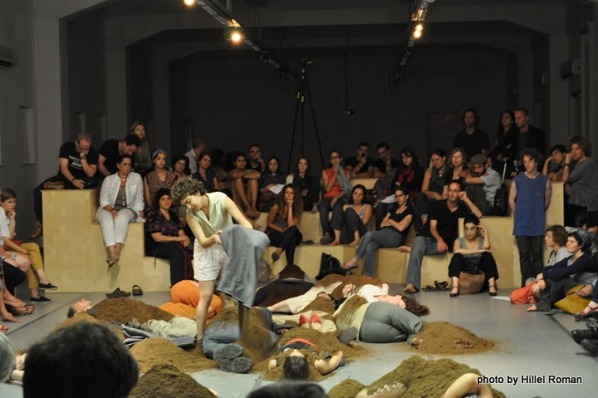
Sculpting in time and the human body like a dance, touching fear and opening the possibility of strangeness, of finding beauty where we dare not look. The evening began in silence; a woman in a light summer dress entered the space slowly, looking around at the audience, acknowledging their presence without word or gesture. Then she lay on the floor and closed her eyes.
Another woman entered carrying two bags. She took handfuls of earth from the bag and covered the first woman’s feet and breasts. Then, she too lay down on the other side of the room. A man entered, once more carrying two gray bags. He poured earth on the second woman, then tenderly removed her glasses and lay down on the floor close by.
The impertinent staccato heels accompanied the entrance of a third woman in a gray chiffon skirt with playful ruffles and a wide red belt to match her red shoes. A woman with attitude, she bounced the bag of dirt on the man’s belly before covering him and lying down.
The relief is almost audible: a pattern has been established. A person enters and lies down then the next in line emerges with bags of dirt and places a symbolic amount of dirt on the first person’s body. One knows what to expect from this point onward, the specter of “buried alive” has been banished; after all, this is art not life.
A blonde woman in a polka-dotted dress entered and lay face down on the floor. A man then entered and poured his two bags of dirt on her head.
All presumed contracts between performers and audience are now null and void – the questions open up again. Can she breathe? Rational thought would indicate that she must and yet, the sight evokes a sensation of suffocation and terror. How does one willingly enter this realm of fear? The performance continued, another woman entered and a man followed her, repeating the established structure. There was no soundtrack to the performance, and not a sound in the room, just the occasional rhythm of footsteps, the slight rustle of clothing, the hush of earth falling on bodies, and the sound of people breathing.
A few notes of soft music touched the silence that had come before, and then grew fuller as a woman in a brown tank top and red-orange pants moved on the wave of sound, curving around the room and spiraling slowly to the floor in a sensuous dance. The music ends with the cessation of motion, and the room returns to its silence. A man in glasses, with a white button down shirt and tie entered briskly after her and covered her with a bag of hamra, (from the Arabic word أحمر that means red), the soft red sand found all along the coast of Israel. He then began to move quickly through the room, removing his tie, like a businessman shaking off the pressures of a hard day’s work, and then he took off his shirt and trousers, and curled up on the floor next to the first woman.
One after another they entered the room, the simplicity and rigidity of the structure creating a space for the individual. Knowing in advance the action to be performed, the attention was on the individual, how each person entered the space differently, filling the moment with her or his presence. A woman carrying her own bags, covering herself with dirt in orgasmic shudders, a man in a blue hoodie exuding hipster diffidence: a casual parade of contemporary humanity.
Art is not life, and at this juncture the narrative moves back in time, to the beginning of the performance. Dr. Roy Brand, Director and Chief Curator of Yaffo 23, had opened the evening with an announcement: “The audience is invited to participate at any moment, during any stage of the performance. At any time that you feel that you would like to participate, you may join.”
Gentle reader, here is where the line between stage and audience disappears – the guard rail is gone, at any moment you may take a leap, at any moment you may fall. I had suspected that this might be the sort of event where the audience is invited to participate, and left my options open, dressing in clothes that I wouldn’t mind getting dirty. Watching the performance, the question remained, a tense wire working its way through my thoughts: would I decide to join the performers?
After the man in the blue hoodie entered the room, another woman entered and then a man from the audience, streaks of blue in his dark curls, rose from the bench and came to rest on the floor beside one of the performers. Throughout the rest of the performance about nine other members of the audience chose to join. I remained taut in my seat, suspended between the desire to experience this ritual of death, and the awareness that from the moment I joined, lying on the ground, my eyes closed, covered with dirt, I would no longer be able to observe and record, in effect – to live.
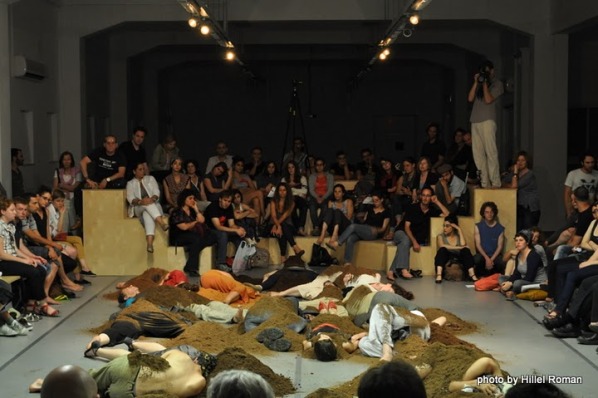
Each person in the room – on the floor and on the benches, experienced the ritual in a different way. As the bodies accumulated on the floor, the composition created its own presence in the room: colorful, conveying the movement of life caught in an extended moment of stillness. Towards the very end, the questions emerge, as a voice enters the space: “When does the beginning suddenly appear? How many beginnings do we have?” The explicit questions reflected back on the performance, as the installation reached its visual completion. Yet even as the words filled the air with signs showing other paths through the work, the room was held the weight of a shared experience, the power of the silent bodies and the implicit questions within: what we are, what we become, and the space in between.
The Future of Death, Part VI, Jerusalem by the A2 Company, is presented by Bezalel Academy of Arts & Design Jerusalem and Bezalel/Yaffo23, Jerusalem in cooperation with The Culture Department and Hazira. The A2 Company’s workshop and performance in Israel is made possible through the BI-ARTS cultural exchange program of the British Council, OUTSET, and the Israeli Foreign Ministry and Ministry of Culture and Sport.

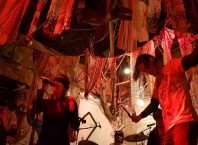
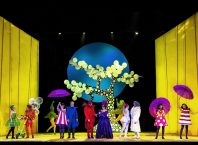


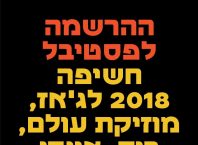
took part in it Jerusalem – was special..
took part in it Jerusalem – was unforgettable!
Interesting. Glad you were there to see it and describe it for me.
beautifully observed and written. thank you for being there, anton from A2
beautiful review! thanks.
Comments are closed.